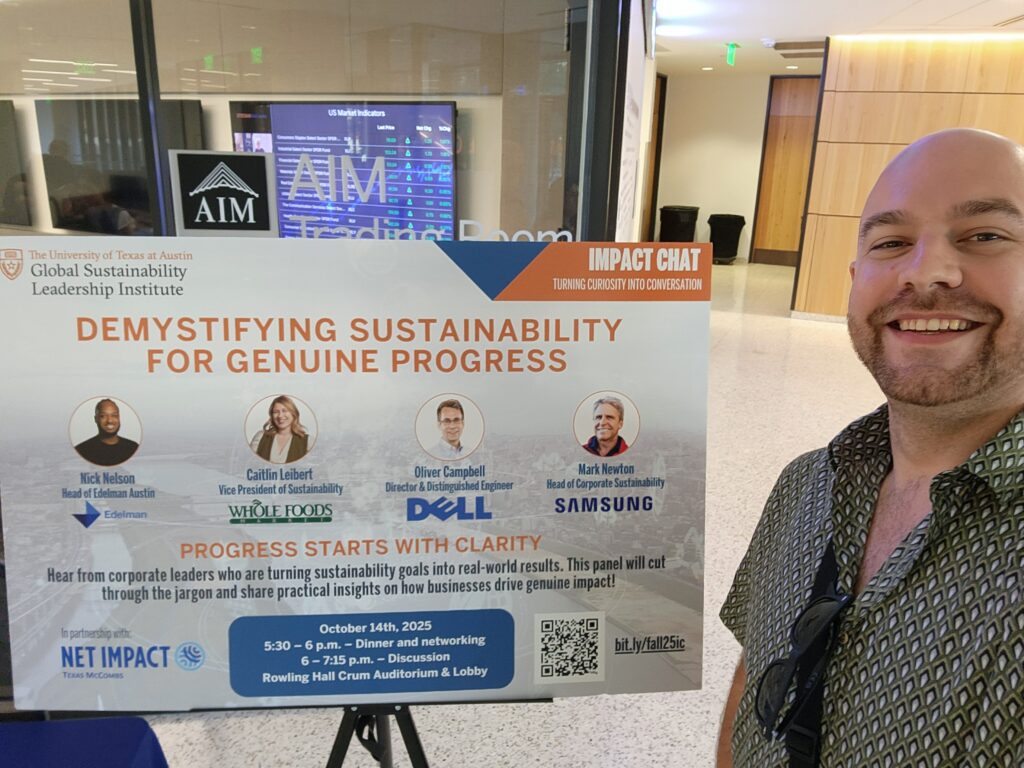Inside the 2025 Greentown Labs ClimateTech Summit
The 2025 Greentown Labs Climatetech Summit brought together hundreds of climate and energy entrepreneurs, corporate leaders, investors, and policymakers to explore the state of innovation at one of the most dynamic moments in climatetech’s evolution.
This year’s theme centered around what speakers described as “Climatetech 3.0”—an era defined by economic feasibility, scalability, and innovation without dependence on green premiums or policy incentives. In other words, the next chapter of climate technology must compete and succeed on the open market; not just as an ethical imperative, but as a smart economic strategy.
As someone who attended the virtual panels in the morning and then joined the startup showcase and networking events in person at Greentown Houston, the day offered an inspiring cross-section of ideas, technologies, and people building a cleaner, more resilient energy future.

- Published in General, Professional, Texas
Hot Rock & Cool Tech: Exploring Advances in Geothermal Energy in Texas
The October Austin Climate Innovation panel took a deep dive underground (literally) with this month’s theme: “Hot Rock and Cool Tech: Advances in Geothermal Energy.”
As renewable energy innovation continues to evolve across Texas, geothermal power is quietly heating up as one of the state’s most promising frontiers. The session featured some of the field’s leading voices: Dr. Shuvajit Bhattacharya with the Bureau of Economic Geology at the University of Texas at Austin, and Edward Humes and Timothy Tarver, founder of Exceed GeoEnergy, who shared both the scientific foundations and the business innovation shaping geothermal’s future.
- Published in General, Professional, Texas
Themes and Takeaways from the 2025 Texan by Nature Conservation Summit
This year’s Texan by Nature Conservation Summit brought together an inspiring cross-section of scientists, business leaders, nonprofits, and landowners to explore one shared goal: how Texas can balance business and natural resource protection in an era of rapid growth. Attending virtually, I was struck by the consistency of the message – conservation isn’t just an environmental cause anymore; it’s a business strategy, a public health tool, and a foundation for resilience.
The panels revealed that the future of conservation in Texas lies at the intersection of data, collaboration, and storytelling. Below are some of the biggest themes and takeaways that stood out – insights that can guide organizations, communities, and individuals working to make measurable change.
1. Conservation as Core Operations
The first theme was clear and powerful: conservation belongs at the center of how we operate businesses and communities, not on the sidelines. When environmental goals are integrated into financial planning, supply chains, and risk management, sustainability becomes part of an organization’s DNA.
- Conservation is no longer optional. The organizations leading the charge, like DFW Airport, Molson Coors, and H-E-B, are showing that sustainability creates operational efficiency and brand strength.
- DFW Airport has been carbon-neutral since 2016, diverting over 90% of construction waste and saving airlines millions in fuel and energy costs – proof that conservation can enhance profitability.
- Molson Coors’ water stewardship projects in the Richland-Chambers watershed have conserved more than 2 billion gallons of water, underscoring how protecting natural resources directly protects production stability.
- H-E-B’s “Trees for Texans” program strategically uses environmental data to guide canopy growth in heat-vulnerable neighborhoods, creating community and ecological benefits while supporting its business footprint.
(more…)Key Lesson: Conservation should be built into core operations, with measurable goals and clear ROI, just like any other business initiative.
- Published in General, Nature, Professional, Texas
Virtually Attending the 2025 Texan by Nature Conservation Summit: Innovation and Impact Across Texas
This year, I had the pleasure of virtually attending the 2025 Texan by Nature Conservation Summit, an annual celebration of the state’s most innovative and impactful conservation work. Though I joined from my desk rather than in person, the experience was deeply meaningful – especially since I first learned about Texan by Nature years ago while working for the Texas Trees Foundation, where we attended this same event as a “conservation wrangler” nominee. Seeing how much the organization has grown since then was both nostalgic and inspiring.
Founded by former First Lady Laura Bush, Texan by Nature (TxN) continues to lead the way in uniting business, community, and conservation for measurable impact across the state. At the center of this effort is the Conservation Wrangler program, a one-of-a-kind accelerator that identifies, supports, and amplifies the most promising conservation initiatives in Texas.
Each year, up to six projects are selected to receive 12–18 months of tailored support – from strategic planning and marketing to data tracking, partnership building, and Return on Conservation™ analysis. The program’s goal is simple but profound: to strengthen conservation outcomes through collaborative partnerships and business-framed conservation ROI, delivering smart and tangible returns for Texas communities and ecosystems alike.
- Published in General, Nature, Professional, Texas
Becoming a Zero Waste Block Leader: How Austin Residents Are Driving Change Locally
I attended the Zero Waste Block Leader Program orientation hosted by Austin Resource Recovery (ARR), and I left feeling both inspired and reconnected to one of my professional passions: waste and resource management.
As Austin continues working toward its ambitious goal of 90% waste diversion by 2040, this program equips residents to play an active role in that mission. The Zero Waste Block Leader Program (ZWBL) trains volunteers to educate their neighbors about recycling, composting, and waste reduction, while also serving as on-the-ground advocates for sustainability. It’s one of those rare opportunities where everyday citizens become part of the city’s environmental strategy – one conversation, one household, and one block at a time.
From Waste Management to Resource Recovery
During my time at Texas Disposal Systems (TDS) (one of Austin Metro’s largest private waste haulers), I developed a strong appreciation for the complex systems that make waste and sustainability work together. Seeing firsthand how recycling streams, compost operations, and landfill logistics function behind the scenes gave me a tangible understanding of what it takes to manage waste at scale.
But what’s always fascinated me most is the communication side of it: how do we take something as unglamorous as trash and turn it into a story that inspires change? That’s exactly where programs like ARR’s Block Leader initiative come in.
(more…)- Published in General, Professional, Texas
Demystifying Sustainability for Genuine Progress: Insights from UT Austin’s Impact Chat
Tonight, I had the opportunity to attend “Demystifying Sustainability for Genuine Progress,” a panel hosted by the Global Sustainability Leadership Institute (GSLI) at UT Austin’s McCombs School of Business. The discussion brought together leading voices in corporate sustainability from Samsung, Whole Foods Market, and Dell Technologies, moderated by Nick Nelson, Vice President at Edelman Austin — who, fun coincidence, shares my last name.
The event explored how sustainability professionals cut through complexity and “green noise” to achieve tangible, lasting impact. It was a refreshing and practical look at how real-world businesses are translating sustainability goals into results that matter — for the planet, for customers, and for the bottom line.



- Published in General, Professional, Texas






